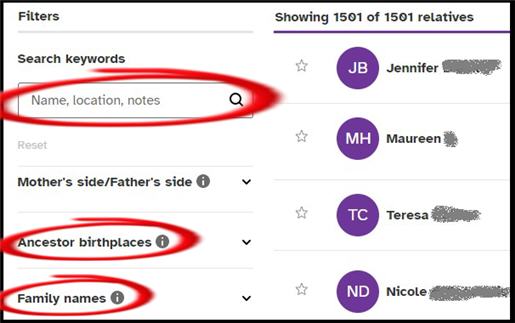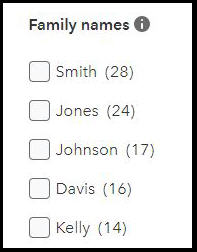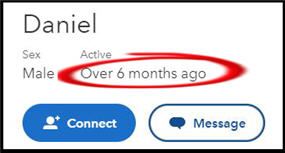Can you find someone specific on 23andMe? Yes, you certainly can if the person meets these criteria:
- DNA tested with 23andMe (and the test is fully processed)
- Agreed to their DNA being matched with relatives
- You are both related within a wide range up to 4th or 5th cousin
- Used their full name in their 23andMe profile (or at least an initial and last name)
Unfortunately, the search features on 23andMe are not as good as some other websites. This article gives you lots of tips on how to narrow down on specific names.
We’ll also steer you away from some glitches that could negatively impact your search.
Who Are You Looking For On 23andMe?
This article assumes that the person you’re looking for isn’t close family e.g. parent, child, or sibling.
We also assume that this is not a case of adoption where you don’t know the legal names.
Instead, we’ll use the scenario that you’re looking for a second or third cousin you remember from childhood. This person moved away and you’ve lost touch.
So, you know the person’s first and last name.
Looking for descendants of a known person
We’ll also cover the scenario where the person is a distant cousin of your parent.
You suspect that they may be deceased, but you’d like to find their children or grandchildren to connect with.
In this case, you’ll be working with the last name only. We’ll give you plenty of tips on narrowing your searches down to that name.
Distant Relatives May Not Show Up On 23andMe
I mentioned that the person can be as distantly related to you as a 4th or 5th cousin. (We have more background on how far back 23andMe goes).
My most distant relative on 23andMe is a fifth cousin. However, your heritage may not be similar to mine.
If all your great-grandparents were born in the United States, you may not see someone who is as distant a relation. How can that happen?
If you are on the standard subscription level with 23andMe, you get a maximum of your top 1,500 DNA relatives.
You may have so many 3rd cousins on every side of your family, that a fourth or fifth cousin doesn’t make your top 1,500.
American users can pay a premium to increase the maximum to 5,000 DNA relatives. You can check out our review of the 23andMe subscriptions and packages.
How Does 23andMe Identify Your Relatives?
I won’t go deep into details of how the process works in this article.
We’ve got a full description in our more general tutorial on researching 23andMe relatives.
It gets into the science behind the website (with easy-to-understand diagrams).
But I’ll review here a question that may be worrying you: the accuracy of what you see.
Could 23andMe be wrong about relationships?
23andMe is very accurate at the level of close family. In general, the more DNA you share with people, the higher the accuracy.
Like all the DNA testing companies, 23andMe becomes less accurate at the lower levels of shared DNA.
Don’t worry about this if you’re looking for a second or third cousin. You share enough DNA for the testing companies to be accurate.
But are you looking for the great-grandchild of the third cousin of your great-grandparent?
Yes, that’s someone in your own generation. But now we’re getting into 5th cousin range where the accuracy of DNA testing is dropping.
Problem with more distant relationships
The problem is that we all share small sections of DNA by chance with unrelated people. This is a consequence of how genetic inheritance works.
So, when you’re looking at “DNA relatives” who share a low level of DNA with you – this may be due to chance instead of common ancestors.
In general, you can be fully confident that the relationship is “real” at levels of about 0.20% and above.
From 0.13% there’s still a high probability that the relationship is due to a common ancestor.
23andMe has a minimum threshold of about 0.11%. Down in those weeds, the chances are higher that this is not a correct relationship (i.e. it’s through chance).
Most People Use Their Full Names On 23andMe
The main reason that you can find someone specific on 23andMe is that most customers use their full names in their 23andMe profile.
In fact, more people do so on 23andMe than on its commercial rival Ancestry DNA. How do I know? I’ve tested with both sites.
About 87% of my DNA relatives on 23andMe use their full names. This makes finding people so possible. The people who use an initial and their last name are also quite identifiable.
If you want to know more about this, I’ve got a detailed article on whether 23andMe shows full names of DNA relatives. You’ll also learn how many people use nicknames, initials, or fake names.
Searching For Someone On 23andMe
The left side of the DNA Relatives list page has search and filter options.

So it makes a whole lot of sense if you start throwing surnames into the keyword search box. That would make sense if this feature worked in a sensible way. But it doesn’t always.
Don’t worry, it’s good enough to find the people you’re looking for. But you need to avoid some traps.
Drawbacks of the search features
One drawback is that keyword search doesn’t distinguish between a name or location. It does a broad word search across the profile of DNA relatives.
So, if you’re looking for a surname of Denver, you could get a whole lot of people who have set this as the birth location of one ancestor.
Another drawback is that you can’t specify that the search is restricted to customer display names. Instead, the search extends into the list of family names that people can provide in their profiles.

In other words, if you’re searching for John Smith – you’ll get people who have specified that their grandmother was a Smith (like me).
You may be thinking that this isn’t a problem if you’re searching for a first and last name together. Unfortunately, this more specific kind of search seems very glitchy.
Beware of using a first and last name in your keyword search
The top person on my list shows her first and last name. When I type these into the keyword search, it comes up empty.
I’ve tried a few DNA relatives with first and last names. Sometimes the search works, and sometimes it doesn’t.
I advise that you stick to using only the last name. If the person has an unusual first name, then enter that as a separate search.
Top tip: use the last name
Even if you’re looking for John Smith, you probably won’t be overwhelmed by hundreds of results. Smith is in my line, and I get about fifty results.
That list is small enough to simply scan through the list, visually looking for John.
The family names filter may be useful…or not
The family names filter is at the bottom of the left pane on the List page. You simply expand the filter to see a list of names you can choose.

This filter works on the list of family names people can enter in the Family Background section.
This will be less useful to you if you’re looking for a relative with a specific surname.
There’s also another drawback. It only gives you the top twenty surnames across your DNA relatives. That may not include the name you’re looking for.
It’s also important to know that many people don’t enter information into the Family Background section. So, you could miss out if you rely on this filter.
This is why I advise you to use the keyword search filter instead.
Don’t Rely On The Predicted Relationship
Let’s say that you know that the person you are looking for is your fourth cousin.
You can browse for people by working through the DNA Relatives list.
23anadMe displays a predicted relationship for each relative on the list page. Be cautious about this!
Here is one of my relatives that is predicted as “4th Cousin”.

This person is actually my 3rd cousin.
Why has 23andMe got this wrong? The reason is that a specific percentage of shared DNA could be held by many relationships.
I could share this amount of 0.29% with a 3rd, 4th, and 5th cousin.
23andMe picks one as a prediction. But keep in mind that the prediction may not apply to this relative.
What To Look For When You Find Someone On 23andMe
Let’s say that you’ve spotted a John Smith. Or hopefully in your case, it’s Algernon Weasley or some other unusual name.
You should look for some more information on their dedicated page. Simply click on the relative in the list.
Here’s what I consider the most useful info.
Most recently active
The “Active” section is useful for predicting how likely it is that someone will reply to your messages via the 23andMe contact system.
Someone who hasn’t logged in in six months may only have been interested in their health reports or their ethnicity breakdown. They may not log in again to view messages.

Family background
The Family Background section is further down the dedicated relative page.
This section shows the background details that people entered on their account profile. That can include grandparents’ birth locations and the family surnames going back generations.

It’s true that many of your relatives won’t provide the information.
However, if your target person has done so, this is a good sign! In general, people who enter these details are more likely to be researching their family history.
This means that they are more likely to be open to contact.
More ways to find details
We have a full article on viewing other peoples’ family trees on 23andMe. It will show you what information you can and can’t view about your DNA relatives.
There may be more info available than you think!
How Do You Know That This “John Smith” Is Who You’re Looking For?
Even if there’s only one DNA relative with the name that you’re looking for, you can’t be immediately sure that this is the correct person.
You can simply message the person at this point and ask them if they’re the child of cousin Ernie. But now you’re waiting for an unknown amount of time. And not everybody replies to messages.
We have some tips on how to message people on 23andMe in ways that are more likely to get replies.
At this point, you can roll up your sleeves and do some more detective work.
Let’s say that the John Smith you’re looking for is on your father’s side of the family. We have a full article on how to find paternal relatives on 23andMe. But I’ll summarize the strategy here.
Open the DNA Relative’s page and scroll down to the bottom. Look for the button marked “Find Relatives In Common”.

This gives you a list of other 23andMe customers that share DNA with both of you. How is this useful?
If you recognize that the top relatives in common are on your mother’s side, then you can probably rule out this 23andMe customer. (This doesn’t apply if your parents are related).
We have a separate tutorial on how to use the 23andMe Relatives In Common feature. You’ll find that it’s a very powerful tool in your detective’s briefcase.
Can You Find Someone With The 23andMe Map Feature?
It’s easy to forget that the Relatives Map feature exists. I often do.
You can find it by looking at the top of the Relatives List page.

The useful thing about this feature is that the locations are defined by what 23andMe customers have entered on their account profile.
In other words, it’s where the customers say that they reside. It’s not where their grandparents were born.
This means that if you lost touch with a cousin who moved to Spain or Australia – this could be a great search tool.
Unfortunately, many customers don’t fill in these details on their accounts. About one-third of mine do. But it’s still worth a try.
As you zoom into the map display, the geography becomes more and more granular. Eventually, you’ll see specific relatives that you can open.
Don’t be misled by the display of initials for your DNA relatives. That’s just for space in this display. Most of them will be using their full name when you open the relative page.
Can You Find Someone With The Genetic Tree Feature?
It’s possible that 23andMe may have done all the research work for you, and slotted the person you’re looking for into your “genetic tree”.
Unfortunately, the odds may not be great. But it’s worth examining the feature.
Check out our full tutorial on using the 23andMe genetic family tree.
Contacting Someone You Find On 23andMe
You contact your DNA relatives by sending messages via the 23andMe messaging system.
Unfortunately, you won’t get responses to every message.
Don’t assume that this is because the person isn’t interested in contact. The emails from 23andMe may be going straight into their spam folders.
However, by finding the person on 23andMe, you are now confident that he or she is likely still alive. This is very useful if it’s someone you only remember from childhood.
If you don’t get a reply via 23andMe, here are my suggestions.
Check with the Relatives In Common feature to see if they have a sibling or other close relative on 23andMe (who are also related to you).
These are more people to contact via 23andMe. If there’s an adult child on the site, they may have arranged the DNA test for your target person. Ask them to pass on a polite message.
If you strike out on 23andMe, then the next resource is to search on social media e.g. Facebook. Good luck!
Use 23andMe To Find People Who Tested Elsewhere
You tested with 23andMe but your long-lost relative has tested with Ancestry.com or MyHeritage.
Buying more kits may be too expensive. But there are some free workarounds to check for relatives who tested elsewhere.
Check out our tutorials:
I am trying to do something unusual! I am trying to see if there is a connection between two people who have both died. One of them is a relative, the other supposedly is not, although the family was visited a lot.